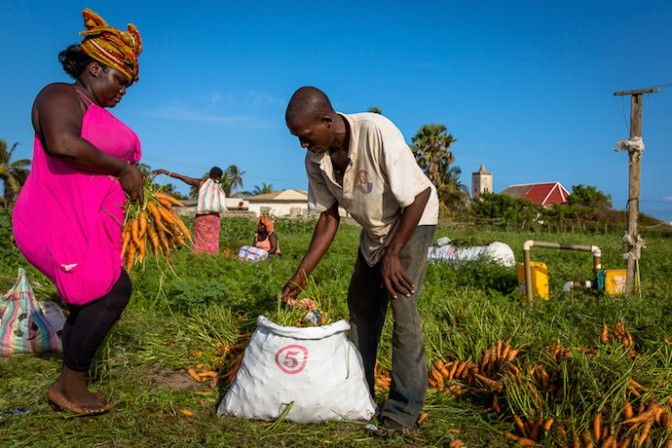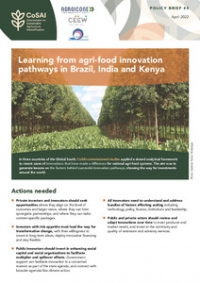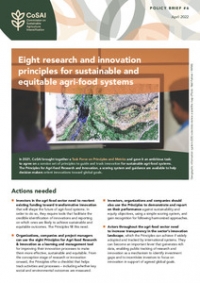Farmers have already tapped into Africa’s groundwater but mostly not in the ‘right’ places. While northern and southern Africa commonly use groundwater for agriculture, because other water resources are less dependable, it’s here that the resource is most likely to be non-renewable. In other words, in these regions, aquifers don’t fill up again or at least not nearly fast enough. When they run out, that’s it. It’s like using a watering can that you can only fill once. It seems like a good idea now but it won’t get you far…
 Farmers in Ada Foah, Ghana harvest carrots grown using groundwater irrigation. Photo: Nana Kofi Acquah
Farmers in Ada Foah, Ghana harvest carrots grown using groundwater irrigation. Photo: Nana Kofi AcquahThere is significant potential, however, to sustainably increase the use of groundwater elsewhere in Africa, and in particular for small-scale farming. In the semi-arid Sahel and East Africa regions, water variability and reliability are still big issues, but groundwater could help bridge those gaps. Recently published research by the International Water Management Institute (IWMI) shows that in these regions, renewable groundwater resources are available and therefore more viable in the long term.
When you consider that only 1% of cultivated land in Africa is irrigated using groundwater, compared to around 14% in Asia, it’s clear what a huge untapped opportunity this presents. In Asia, irrigation, which includes the use of groundwater resources, has led to significant advances in food security and improvements in livelihoods. It has been estimated, in 13 African countries alone, that groundwater offers the potential for a 120-fold increase (13.5 million hectares) in the total area under irrigation. This could improve livelihoods for approximately 40% of the present-day rural population. Overall, groundwater resources in Africa are plentiful but unevenly distributed and underutilized.
Sustaining groundwater resource availability
Some African farmers have already embraced groundwater irrigation. Their enthusiasm is spurred by improved access to low-cost technologies for pumps and drilling services as well as market opportunities for the resulting produce. But how can farmers, communities and policy makers make sure that Africa doesn’t make the same mistakes that other parts of the world have made by unsustainably using these finite underground water resources?
One solution to increase the viability is to help provide farmers with choices so that they can pick crop types that require less water. Another is to ensure better irrigation efficiency and assist farmers in adapting local management skills to adjust the extent of irrigation use to the resources available.
Mapping resources
A third important factor, which also helps guide policy making to support these initiatives, is to identify where groundwater can be sustainably used for irrigation. This means evaluating total renewable groundwater availability in specific areas and then working out how much, and how large areas, can be used for irrigation. Other human demands on these resources such as household use, industrial uses, watering livestock, and environmental requirements, need to be factored in.
An IWMI team has mapped crop areas that can be irrigated with renewable groundwater in Africa at a continental scale, initially disregarding sociologic, economic or technical constraints. They developed three potential scenarios to account for environmental requirements connected to groundwater. These represent situations where environmental requirements account for 30%, 50% and 70% of groundwater recharge. This approach reflects recognition of the considerable uncertainty around environmental groundwater requirements. The main reason for this is the lack of knowledge on the location and functioning of ecosystems dependent on groundwater at the continental scale and on how much water they actually need. The mapping, based on resource availability, is now being further developed to take into account technical and socio-economic aspects.
Where is the highest potential?
Researchers then focused on six major irrigated crop groups that in 2000 accounted for an average of 84% of the total harvested cropland. These included: cereals, oil crops, roots, pulses, vegetables and sugar crops. The team calculated the groundwater irrigation potential using the maximum annual estimate of irrigation water demand for the relevant crops grown in each identified area.
“These results show that average annual renewable groundwater availability for irrigation ranges from 692 to 1644 km3 depending on scenario” says Yvan Altchenko, a hydrogeologist at IWMI “The total area of cropland irrigable with renewable groundwater ranges from 45 million to 105 million hectares. This equals 21 - 49% of Africa’s cropland.”
Rainfall and recharge are highest in the equatorial region of Africa so this is where renewable groundwater availability for irrigation is also highest, but also less relevant. In parts of northern and southern Africa however, there’s generally not enough rainfall to sufficiently recharge aquifers. Here irrigation using groundwater from renewable resources can only take place at a small scale or opportunistically after large recharge events and only after considering other water demands.
Total area under irrigation from groundwater resources in Africa can safely be expanded 20 times or more beyond current levels, but not everywhere.
The maps show that in Angola, Ethiopia, Mozambique and Tanzania in particular there are big differences in groundwater irrigation potential from one region to another, within each country. Knowing exactly where in Tanzania, for example, use of groundwater in irrigation will be sustainable and where it would deplete a finite resource could be crucial to future food security and the viability of ecosystems dependent on the resource.
Overall the research indicates that the total area under irrigation from groundwater resources in Africa can safely be expanded 20 times or more beyond current levels, but not everywhere. This could have considerable positive impacts for farmer livelihoods, and national and regional food security, particularly in the Sahel and semi-arid regions of east Africa.














